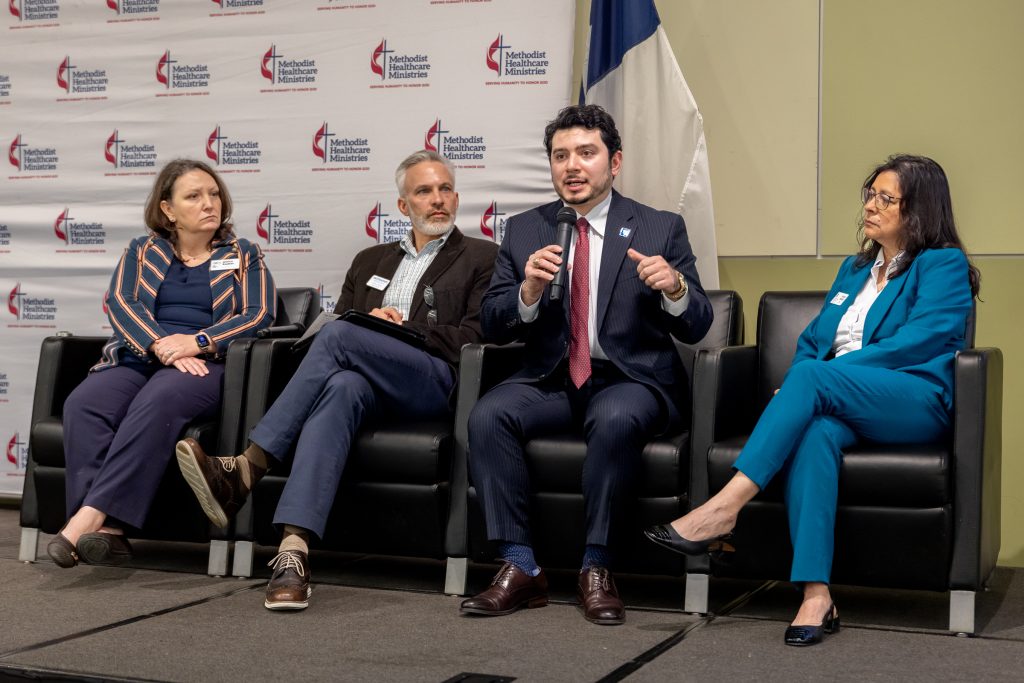Texas ranks near the worst in the nation on child well-being indicators: 43rd in economic security and education and 48th in health, according to the 2024 Texas Kids Count report released on Thursday.
The annual study by Every Texan and Methodist Healthcare Ministries of South Texas, Inc. reveals that children of color living in poverty are the state’s most underserved children and are facing significant disparities when compared to their peers.
The databook details how Texas children’s well-being is affected by a variety of challenges in key areas of their lives, including health, education and economic security. Read the full Kids Count Databook report and explore the data dashboard here.
People who work with children across several sectors including early childhood, criminal justice, education and health gathered at the San Antonio Food Bank to hear experts talk about the report’s findings.
Texas Tribune reporter Stephen Simpson asked the expert panel about what the findings meant for local communities and how lawmakers could address the disparities affecting Texas children.
Mental health is a critical issue for kids in Texas, according to the data. More kids reported having anxiety and depression and there is an alarming rise in suicide attempt rates, especially among Black and multiracial children.
Jessica Knudsen, CEO of Clarity Child Guidance Center, the only nonprofit mental health treatment center for kids ages 3 to 17 in South Texas, said schools should run mental health screenings on students to connect them directly with available mental health treatment.
Still, partial hospitalization isn’t a covered Medicaid benefit.
“But that has proven to keep crises from escalating,” she said. “It takes eight years from the first onset of symptoms to get treatment. … Good quality intervention can keep difficulty and crises from happening down the road.”
The Texas Legislature has an opportunity to address the issue by focusing on ensuring children eligible for Medicaid or CHIP coverage are being enrolled.
Texas still has the highest rate of uninsured children, most of whom are children, but about 400,000 kids are eligible for Medicaid but are just not enrolled, said Alec Mendoza, senior policy associate for health at Texans Care for Children, a nonprofit that works with families and data to change policy.
Most of the time because families lack the knowledge or awareness, he says.
“This means our eligibility criteria is confusing,” Mendoza said, “They don’t have things like wait times, callback options … These issues lead to the numbers we’re seeing here today.”
Texas has 120,000 Medicaid applications in its queue as of January and families are waiting more than 50 days to have their application looked at, Mendoza said.
“This is having a severe impact on our kids,” he said.
Experts said protecting access to Medicaid and CHIP for eligible children can avoid future coverage loss, expanding funding for school-based services or partnering with organizations for mental health programs and promoting immunization can help address the health disparities kids are facing in Texas.
“When your kid is 16 and has an anxiety attack, what do you do?,” Knudsen said. “If it’s truly an emergency, 911 is there, and San Antonio has done a good job of training officers on how to respond to those emergencies, but we’re there 24/7.”
More than half of calls to 911 are for nonemergencies, and are things related to mental health or medication run out, an indication that there are no systems in place to address these gaps, said Mark Larson, executive director of Early Matters San Antonio, an advocacy group for early childhood education.
“It happens in early childhood,” he said. “The 0 to 5 space is a nonsystem. There are no districts … We have not built here in Texas [a system] for our youngest learners who often are also the most vulnerable to some of these challenges.”
Experts talked about expanding pre-K, focusing on childcare workers and childcare centers to help families get more access to child care in Texas, since many centers, even in San Antonio, are taking less kids than they can actually accommodate because of staffing issues.
“One of the core functions of K-12 schools is a place to stash the kids while we go to work. K-12 came back [after the pandemic], early childhood didn’t,” Larson said. “Families are going to continue to experience a higher percentage of adverse childhood experiences … their ability to perform is going to be significantly hampered.”
According to the report, 84% of Texas children enrolled in pre-K in 2024 were economically disadvantaged and 36% were bilingual or English learners.
Data in the book correlates with other issues, like attendance, said Jessica Weaver, chief executive officer of Communities in School of San Antonio.
“It’s about the staff going to the home, finding out what’s causing the issues, and what we’ve found is that the intervention that had the best outcomes [to addressing attendance] was addressing the basic needs of families,” she said.
The amount of children experiencing food insecurity in South Texas is only surpassed by those living in the southeast part of the state. As panelists discussed these issues, food bank volunteers on the first floor were packing food boxes that were to be passed out to families lined up in cars waiting outside.
“Not having clothes you need, those are things that create anxiety. Identifying needs and having interventions that support the root cause and not just seeing it as an absence is the most important thing we need to do,” Weaver said.
But what kids are most worried about is school safety, she said.
“We have to create spaces for our kids to feel safe on the emotional side and not just on the physical side,” she said. “We have to resource schools to do that for kids.”








